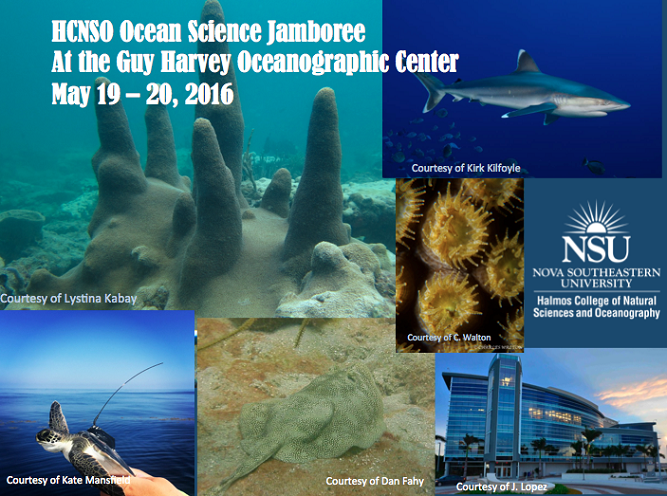Historic undersampling of deep-pelagic top predators: a case study of the Chiasmodontidae of the Gulf of Mexico using multiple sampling gears
Location
Guy Harvey Oceanographic Center Facility
Start
5-19-2016 3:30 PM
End
5-19-2016 3:45 PM
Abstract
The deep-pelagic (incl. meso- and bathypelagic) domain has been historically sampled using relatively small research trawls (ring nets, modified otter trawls, rectangular trawls, International Young Gadoid Trawls, and MOCNESS trawls), which have shaped what we know about midwater taxa. The towing speed, effective mouth area, and mesh sizes of the gears mentioned mainly select for macroplankton and micronekton, as larger nekton can outswim or outmaneuver these nets. Researchers are increasingly using larger, commercial-sized high speed rope trawls to sample the deep-pelagial. An example is the Offshore Nekton Sampling and Analysis Program (ONSAP), a component of NOAA’s Natural Resource Damage Assessment following the Deepwater Horizon oil spill. The ONSAP employed two types of midwater trawls to collect deep-pelagic fauna in the northern Gulf of Mexico between 0-1500 meters depth; a 10-m2 MOCNESS (MOC10) and a commercial-sized, high-speed Irish Herring Trawl (IHT). Data will be presented comparing the catches of the Chiasmodontidae, a top meso/bathypelagic predator family, from the two gear types. The IHT collected 1,060 specimens in 146 of 167 trawls (87% frequency), compared to only 87 specimens collected by the MOC10 in 68 of 241 trawls (28% frequency). A minimum of 15 species of chiasmodontids were collected with the IHT (currently all Chiasmodon identifications are C. niger complex, pending revision), while eight were collected with the MOC10. Comparisons of standardized abundance and length frequencies will be presented as evidence and incentive for employing multiple trawl types to gain a more comprehensive understanding of the deep-pelagial, earth’s largest biome.
Presenter(s) Biography
More information about April Cook can be found at:
http://www.deependconsortium.org/index.php?option=com_content&view=article&id=60
Historic undersampling of deep-pelagic top predators: a case study of the Chiasmodontidae of the Gulf of Mexico using multiple sampling gears
Guy Harvey Oceanographic Center Facility
The deep-pelagic (incl. meso- and bathypelagic) domain has been historically sampled using relatively small research trawls (ring nets, modified otter trawls, rectangular trawls, International Young Gadoid Trawls, and MOCNESS trawls), which have shaped what we know about midwater taxa. The towing speed, effective mouth area, and mesh sizes of the gears mentioned mainly select for macroplankton and micronekton, as larger nekton can outswim or outmaneuver these nets. Researchers are increasingly using larger, commercial-sized high speed rope trawls to sample the deep-pelagial. An example is the Offshore Nekton Sampling and Analysis Program (ONSAP), a component of NOAA’s Natural Resource Damage Assessment following the Deepwater Horizon oil spill. The ONSAP employed two types of midwater trawls to collect deep-pelagic fauna in the northern Gulf of Mexico between 0-1500 meters depth; a 10-m2 MOCNESS (MOC10) and a commercial-sized, high-speed Irish Herring Trawl (IHT). Data will be presented comparing the catches of the Chiasmodontidae, a top meso/bathypelagic predator family, from the two gear types. The IHT collected 1,060 specimens in 146 of 167 trawls (87% frequency), compared to only 87 specimens collected by the MOC10 in 68 of 241 trawls (28% frequency). A minimum of 15 species of chiasmodontids were collected with the IHT (currently all Chiasmodon identifications are C. niger complex, pending revision), while eight were collected with the MOC10. Comparisons of standardized abundance and length frequencies will be presented as evidence and incentive for employing multiple trawl types to gain a more comprehensive understanding of the deep-pelagial, earth’s largest biome.


